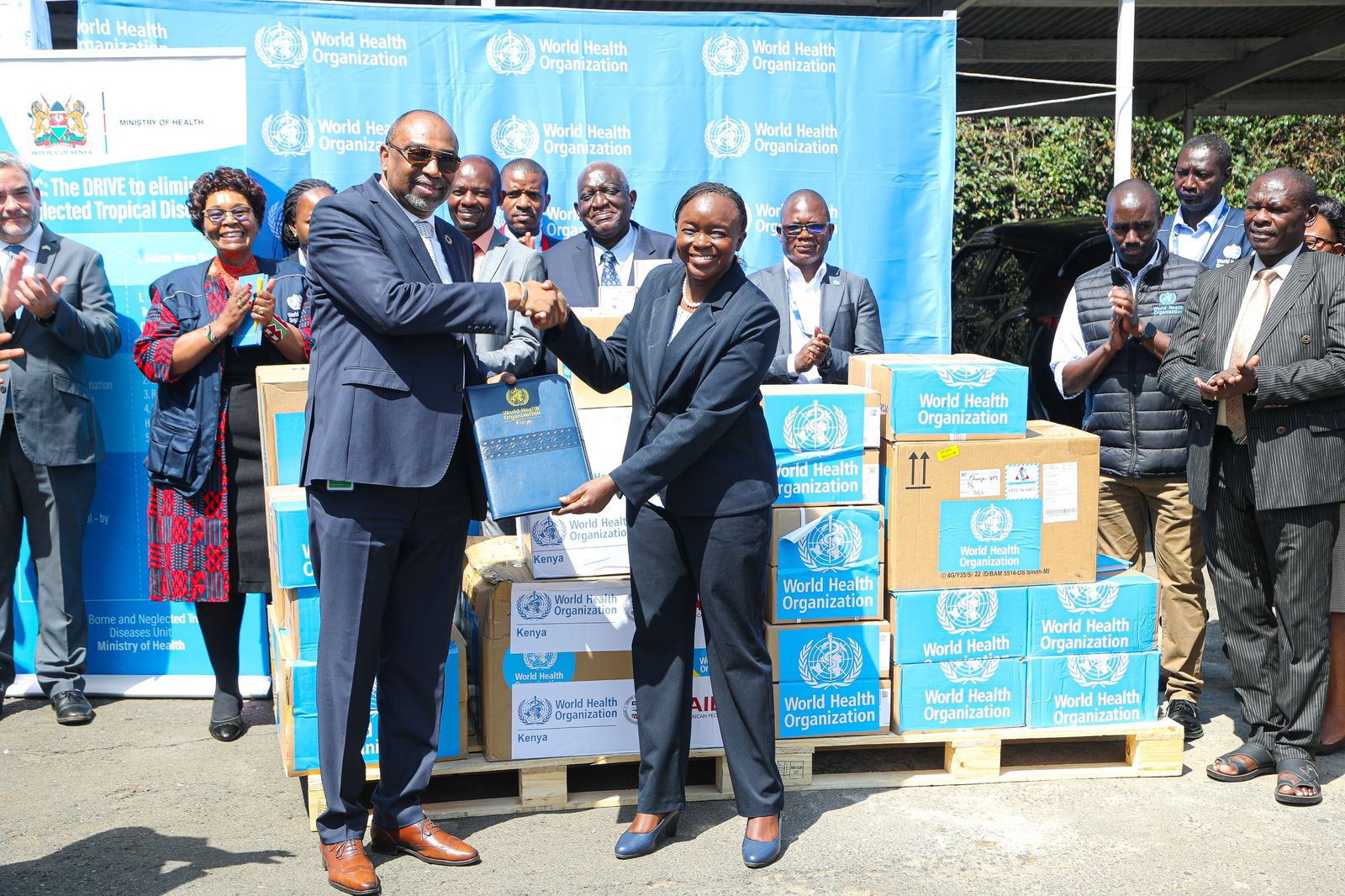Kenya has received Mpox sample collection kits to strengthen its capacity for accurate and timely diagnostic testing.
The 28 PCR diagnostic kits for testing 2,688 suspected Mpox samples, along with 2,500 scalpel blades, viral transport media, and swabs for sample collection donated by USAID through the World Health Organization Country (WHO) will facilitate rapid detection and response to the mpox outbreak in the country.
Health Cabinet Secretary Dr Deborah Barasa received the testing kits during a handing-over ceremony Monday morning at Afya House.
USAID has also allocated USD 500,000 to WHO Kenya towards strengthening Kenya’s Ministry of Health response to the ongoing Mpox outbreak.
Additionally, WHO has supported the ministry in developing a national Mpox preparedness and response plan, targeting 14 high-risk counties.
Update status
Kenya has so far reported 13 mpox cases from 238 samples across 10 counties of Nakuru, Kajiado, Taita Taveta, Busia, Mombasa, Bungoma, Kericho, Kilifi and Nairobi.
Health Director-General Patrick Amoth stated that one patient with underlying health complications had succumbed.
“Eight of those have recovered and have gone home, four are still admitted in hospital,” said Amoth.
Kenya has not reported cases of Malburg despite receiving an alert from WHO on the Virus Disease.
“This timely support comes as our nation grapples with an ongoing Mpox outbreak. The introduction of these testing kits will enhance our capacity to detect and respond to Mpox cases more swiftly and effectively, ultimately saving lives and curbing the spread of this outbreak” Barasa said.
The CS further appealed for further support to expand the capacity of the country’s National Public Health Laboratory Services (NPHLS) to include testing for Marburg and other high-risk pathogens.
She highlighted the need to establish advanced Biosafety Level 3 laboratories to handle dangerous pathogens securely.
“ We must recognize that our efforts cannot stop here. Emerging health threats, such as the Marburg virus reported in neighbouring countries, highlight the necessity of proactive measures to prevent future outbreaks” she stated.
“Looking ahead, there are critical areas where we urgently need additional support. These include the establishment of advanced Biosafety Level 3 laboratories to handle dangerous pathogens securely, increasing our genomic sequencing capacity to better identify and track infectious agents, and building bioinformatics expertise within the NPH” she explained.
With over 300 laboratories accredited, Dr Barasa highlighted the significant progress in improving diagnosis, treatment management, and surveillance for a wide array of diseases—from infectious agents to non-communicable diseases and Neglected Tropical Diseases (NTDs).
“With over 300 laboratories accredited or on the path to accreditation, we remain committed to upholding international standards, including ISO 15189, 17025, and 17043. This commitment ensures that we provide high-quality services to the people of Kenya” she assured.
Neglected Tropical Diseases
The event also showcased the Ministry’s continued efforts to combat Neglected Tropical Diseases (NTDs) and address emerging public health challenges such as Mpox and Marburg.
WHO donated 15,215,000 tablets of NTD medicines valued at USD 1,655,112 which will be used for a mass drug administration later this month, aimed to reach over 15 million people across 15 targeted counties in Kenya.
“Through the implementation of targeted interventions, including the deployment of preventive chemotherapy, we have made remarkable strides against NTDs. The mass drug administration (MDA) campaigns play a pivotal role in our fight by targeting at-risk communities and interrupting the cycle of disease transmission” she noted as she received drugs for MDA.
The medicines will be put to immediate use in the upcoming cycle of MDA to address three endemic NTDs: lymphatic filariasis, soil-transmitted helminths, and schistosomiasis.
“Our focus will be on the Coastal region, Lake Victoria basin, and Western regions, where the burden of these diseases remains highest” she disclosed.
The government has committed to the goal of eliminating priority endemic NTDs by 2028, as outlined in the third National Master Plan for the Elimination of NTDs (2023-2027).
“With this support, we believe Kenya will continue to enhance its efforts towards the elimination of Schistosomiasis and STH by 2030, ultimately enhancing the health outcomes for millions of individuals” observed Dr. Abdourahmane Diallo, the World Health Organization Representative – Kenya.
Community Health Promoters will play a key role in the execution of MDA in endemic counties.
Consequently, the teams conducting the MDA have been directed to register all household members they visit for the Social Health Insurance Fund under the Social Health Authority to enable them to access affordable services under the Universal Health Coverage (UHC) programme.
At the beginning of this year, MOH laid out strategic measures to combat six debilitating NTDs—Schistosomiasis, Intestinal Worms, Lymphatic Filariasis, River Blindness, Visceral Leishmaniasis, and Trachoma.
The five-year National Master Plan for Elimination of Neglected Tropical Diseases (NTDs) 2023-2027 guides a multi-sectoral collaborative effort to free the country from the shackles of NTDs.
Kenya targets to transition from disease-specific interventions to an integrated approach, optimizing resources and minimizing duplication of effort in the next five years.
The master plan delineates key strategies, interventions, targets, roles, and responsibilities to ensure a coordinated and effective approach to the prevention, control and elimination of NTDs.
#BigNews: 15 million tablets for Neglected Tropical Disease have arrived in Kenya for the mass drug administration this October! 🇰🇪
Coordinated by @WHO, these medicines will help combat diseases like Schistosomiasis and STH, pushing us closer to elimination by 2030. pic.twitter.com/5XkYOl0xsa
— WHO Kenya (@WHOKenya) October 6, 2024





